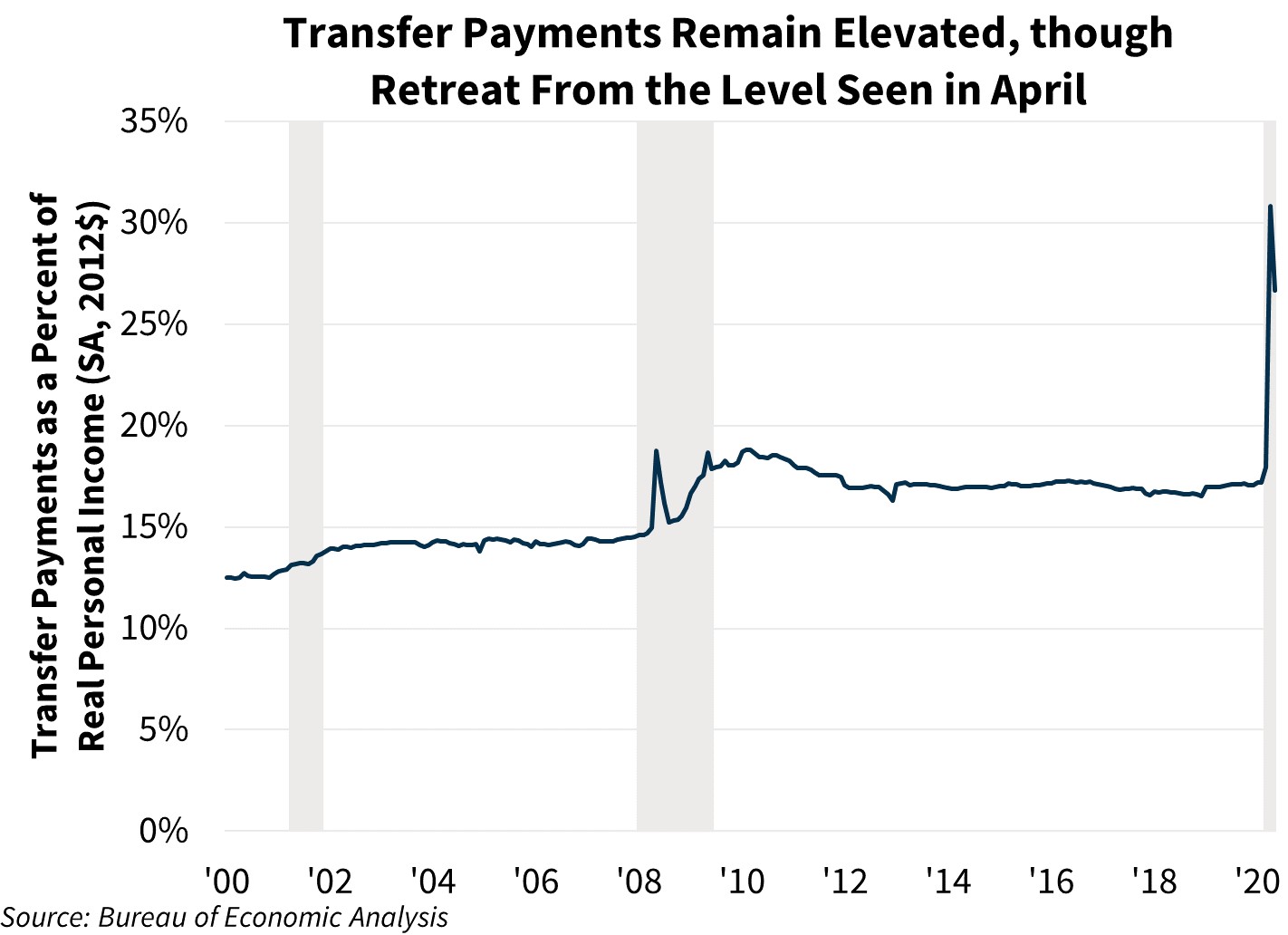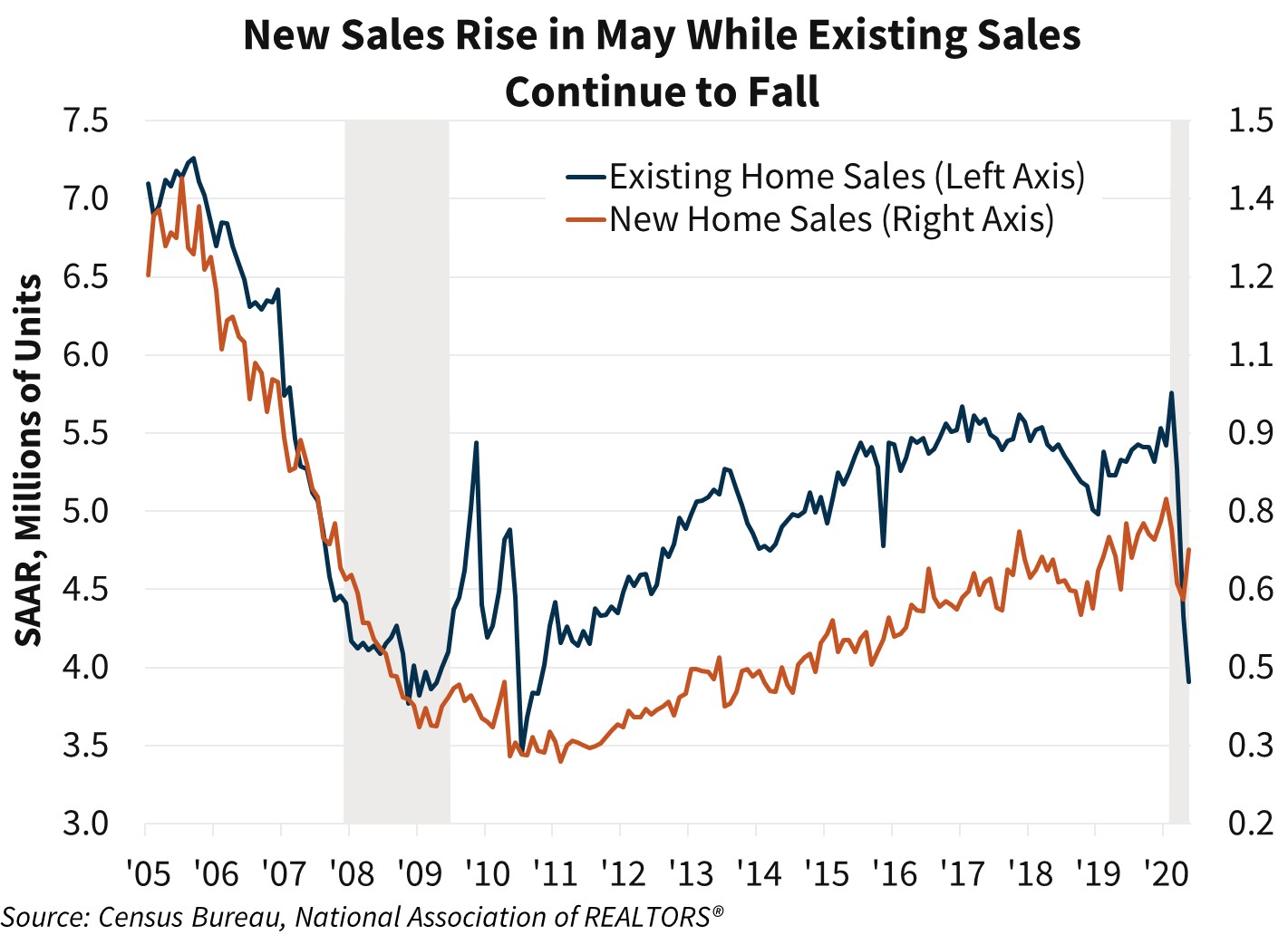Consumption Increases as Businesses Reopen
Key Takeaways:
- Personal income, adjusted for inflation, fell 4.3 percent in May, according to the Bureau of Economic Analysis. though the overall level remains elevated. This was the largest monthly decline since January 2013. The May decline was driven by a sharp pullback in government transfer payments, which fell 17.3 percent after rising 91.6 percent in April, as the one-time stimulus payment was distributed almost entirely in April.
- Real personal consumption expenditures rose 8.1 percent, the largest increase in series history, as the economy began reopening in May. The savings rate fell from 32.2 percent to 23.2 percent. From a year ago, the PCE price index rose 0.5 percent, a slight deceleration from April, while the core PCE price index rose 1.0 percent, unchanged from April.
- The University of Michigan Consumer Sentiment Index increased 5.8 points in the final June reading. Both the current economic conditions and expectations components rose. According to the press release, the headline index rose the least among Southern and Western residents, while the index for residents in the Northeast rose by an all-time record as residents there are “apparently expecting the later and more gradual reopening to produce a negligible increase in infections.”
- Durable goods orders rebounded partially in May, posting the largest increase in almost six years after April’s steep decline, according to the Census Bureau. The increase was driven by new orders for transportation equipment, which rose 80.7 percent, up from the lowest level in series’ history in April. Excluding transportation, new orders rose 4.0 percent. Shipments of durable goods increased 4.4 percent. Orders and shipments of core capital goods (nondefense excluding aircraft) both rose for the first time since January.
- New single-family home sales rose 16.6 percent in May to a seasonally adjusted annualized rate (SAAR) of 676,000, according to the Census Bureau. The previously reported slight increase in April was revised downward to a decline of 5.2 percent. Regionally, sales rose everywhere except for the Midwest. The inventory of new homes for sale fell to the lowest level in almost two years and posted the largest annual decline since 2012. The months’ supply fell by 1.1 to 5.6 months. From a year ago, the median sale price rose 1.7 percent.
- Existing home sales fell 9.7 percent in May to a SAAR of 3.91 million, the lowest level since October 2010, according to the National Association of REALTORS®. Single-family sales fell 9.4 percent to a SAAR of 3.57 million, and condo/co-op sales decreased 12.8 percent to a SAAR of 340,000, the lowest reading since the series began in 1999. The months’ supply for total existing homes jumped eight-tenths to 4.8 (non-seasonally adjusted), the highest May level since 2015. From a year ago, total existing homes available for sale fell 18.8 percent, the twelfth straight month of annual declines.
Forecast Impact
The economy has shown signs of improvement from the severe weakness seen through April as states began reopening in May. While personal income fell in May, this was mainly due to a pullback in government transfer payments as most people received their one-time stimulus payments in April. Despite this, personal consumption expenditures increased by slightly more than we had expected as businesses reopened and consumer confidence partially recovered. The savings rate also remained elevated, likely supporting future consumer spending. However, it is possible that a continued resurgence in new cases could prompt consumers to self-isolate and governments to slow reopenings, which could lead to further declines in sentiment and spending. Business investment appears to have benefitted from the reopening process as well, with the sharp rise in durable goods orders suggesting a somewhat stronger level of business fixed investment in the second quarter, though most of the gain was from the volatile transportation equipment series. In housing, demand for new single-family homes remained strong, while existing sales continued to struggle. A shortage of available inventory will likely limit sales growth in either category, though we believe new sales may get a boost if the level of new construction can keep up. While new sales improved in line with our expectations, the large downward revision to April sales resulted in a considerably lower base level than we had forecast.


Economic and Strategic Research Group
June 26, 2020
Opinions, analyses, estimates, forecasts and other views of Fannie Mae's Economic and Strategic Research (ESR) Group included in these materials should not be construed as indicating Fannie Mae's business prospects or expected results, are based on a number of assumptions, and are subject to change without notice. How this information affects Fannie Mae will depend on many factors. Although the ESR group bases its opinions, analyses, estimates, forecasts and other views on information it considers reliable, it does not guarantee that the information provided in these materials is accurate, current or suitable for any particular purpose. Changes in the assumptions or the information underlying these views, including assumptions about the duration and magnitude of shutdowns and social distancing, could produce materially different results. The analyses, opinions, estimates, forecasts and other views published by the ESR group represent the views of that group as of the date indicated and do not necessarily represent the views of Fannie Mae or its management.
